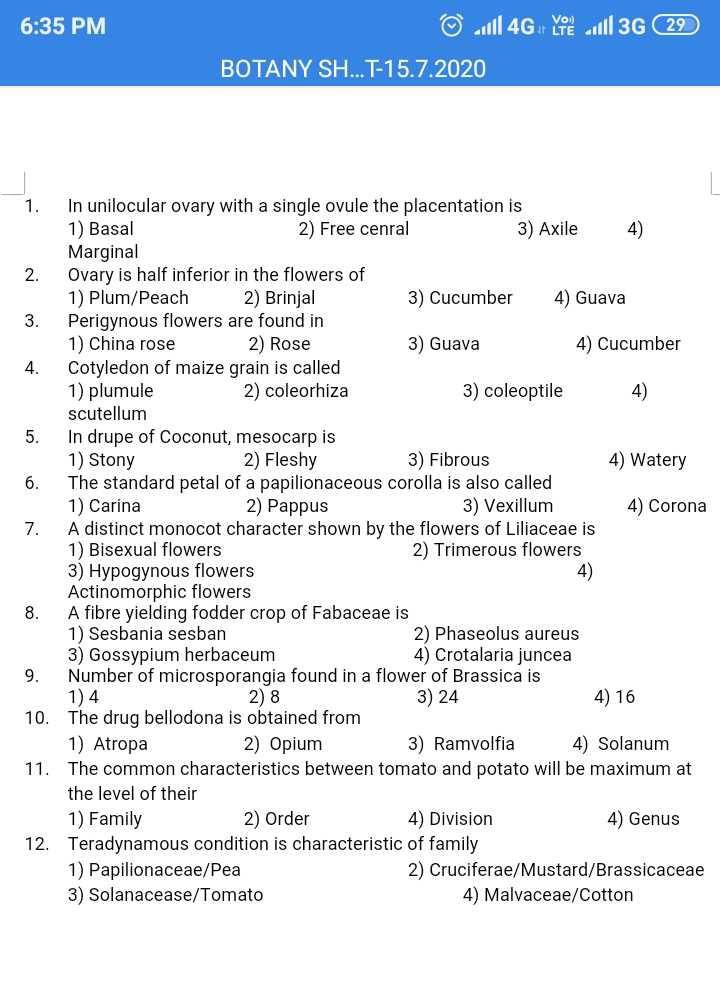Class 11 Exam > Class 11 Questions > Needed a Test for Morphology of flowering pla...
Start Learning for Free
Needed a Test for Morphology of flowering plants?
Most Upvoted Answer
Needed a Test for Morphology of flowering plants? Related: Morpholog...

Community Answer
Needed a Test for Morphology of flowering plants? Related: Morpholog...
Morphology of Flowering Plants
Flowering plants, also known as angiosperms, are the most diverse group of plants on Earth. They exhibit a wide variety of forms and structures, which are collectively known as the morphology of flowering plants. Understanding the morphology of flowering plants is essential for the study of plant anatomy, physiology, and taxonomy.
Key Concepts in Morphology of Flowering Plants
- Roots: The underground part of the plant responsible for anchoring it in the soil and absorbing water and nutrients.
- Stems: The above-ground part of the plant that supports leaves, flowers, and fruits and transports water, nutrients, and sugars.
- Leaves: The primary photosynthetic organs of the plant, responsible for capturing sunlight and producing food.
- Flowers: The reproductive structures of flowering plants, responsible for pollination and seed formation.
- Fruits: The mature ovaries of flowers, containing seeds and facilitating seed dispersal.
- Seeds: The reproductive structures produced by flowering plants, containing embryos and stored food.
Test for Morphology of Flowering Plants
1. Identify the following plant structures:
- The part of the plant responsible for anchoring it in the soil.
- The above-ground part of the plant that supports leaves and flowers.
- The primary photosynthetic organs of the plant.
- The reproductive structures of flowering plants.
- The mature ovaries of flowers.
- The reproductive structures produced by flowering plants.
2. Label the parts of a flower:
- Sepals
- Petals
- Stamens
- Carpels
3. Describe the functions of the following plant structures:
- Roots
- Stems
- Leaves
- Flowers
- Fruits
- Seeds
4. Explain the process of pollination and its significance in seed formation.
5. Discuss the different types of fruit and their adaptations for seed dispersal.
6. Compare and contrast monocot and dicot plants based on their morphological features.
Conclusion
Understanding the morphology of flowering plants is crucial for comprehending their structure, function, and evolutionary adaptations. By testing your knowledge on the key concepts and structures related to the morphology of flowering plants, you can reinforce your understanding of this important topic in biology.
Attention Class 11 Students!
To make sure you are not studying endlessly, EduRev has designed Class 11 study material, with Structured Courses, Videos, & Test Series. Plus get personalized analysis, doubt solving and improvement plans to achieve a great score in Class 11.

|
Explore Courses for Class 11 exam
|

|
Similar Class 11 Doubts
Needed a Test for Morphology of flowering plants? Related: Morphology Of Flowering Plants, Chapter Notes, Class 11, Biology?
Question Description
Needed a Test for Morphology of flowering plants? Related: Morphology Of Flowering Plants, Chapter Notes, Class 11, Biology? for Class 11 2024 is part of Class 11 preparation. The Question and answers have been prepared according to the Class 11 exam syllabus. Information about Needed a Test for Morphology of flowering plants? Related: Morphology Of Flowering Plants, Chapter Notes, Class 11, Biology? covers all topics & solutions for Class 11 2024 Exam. Find important definitions, questions, meanings, examples, exercises and tests below for Needed a Test for Morphology of flowering plants? Related: Morphology Of Flowering Plants, Chapter Notes, Class 11, Biology?.
Needed a Test for Morphology of flowering plants? Related: Morphology Of Flowering Plants, Chapter Notes, Class 11, Biology? for Class 11 2024 is part of Class 11 preparation. The Question and answers have been prepared according to the Class 11 exam syllabus. Information about Needed a Test for Morphology of flowering plants? Related: Morphology Of Flowering Plants, Chapter Notes, Class 11, Biology? covers all topics & solutions for Class 11 2024 Exam. Find important definitions, questions, meanings, examples, exercises and tests below for Needed a Test for Morphology of flowering plants? Related: Morphology Of Flowering Plants, Chapter Notes, Class 11, Biology?.
Solutions for Needed a Test for Morphology of flowering plants? Related: Morphology Of Flowering Plants, Chapter Notes, Class 11, Biology? in English & in Hindi are available as part of our courses for Class 11.
Download more important topics, notes, lectures and mock test series for Class 11 Exam by signing up for free.
Here you can find the meaning of Needed a Test for Morphology of flowering plants? Related: Morphology Of Flowering Plants, Chapter Notes, Class 11, Biology? defined & explained in the simplest way possible. Besides giving the explanation of
Needed a Test for Morphology of flowering plants? Related: Morphology Of Flowering Plants, Chapter Notes, Class 11, Biology?, a detailed solution for Needed a Test for Morphology of flowering plants? Related: Morphology Of Flowering Plants, Chapter Notes, Class 11, Biology? has been provided alongside types of Needed a Test for Morphology of flowering plants? Related: Morphology Of Flowering Plants, Chapter Notes, Class 11, Biology? theory, EduRev gives you an
ample number of questions to practice Needed a Test for Morphology of flowering plants? Related: Morphology Of Flowering Plants, Chapter Notes, Class 11, Biology? tests, examples and also practice Class 11 tests.

|
Explore Courses for Class 11 exam
|

|
Suggested Free Tests
Signup for Free!
Signup to see your scores go up within 7 days! Learn & Practice with 1000+ FREE Notes, Videos & Tests.

























